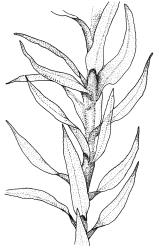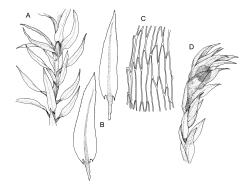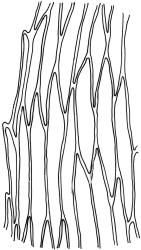- ≡ Hypnum wahlenbergii F.Weber & D.Mohr, Bot. Taschenb. (Weber) 280, 475 (1807)
- ≡ Webera wahlenbergii (F.Weber & D.Mohr) Fürnr., Flora 12(2 Ergänzungsblätter): 35 (1829)
- ≡ Mniobryum wahlenbergii (F.Weber & D.Mohr) Jenn., Man. Mosses W. Pennsylvania 146 (1913)
- = Pohlia albicans Lindb., Musci Scand. 17 (1879) nom. illeg.
- = Mniobryum tasmanicum Broth., Öfvers. Finska Vetensk.-Soc. Förh. 35: 48 (1893)
- ≡ Pohlia tasmanica (Broth.) Dixon, Bull. New Zealand Inst. 3: 201 (1926)
- = Bryum binnsii R.Br.bis, Trans. & Proc. New Zealand Inst. 31: 456 (1899)
Plants white- or glaucous-green when fresh, usually tinged pink or copper, not or scarcely lustrous, forming turves (often extensive) or scattered among other mosses. Stems variable in length, to at least 35 mm, pink, in cross-section angled, with incrassate cortical cells and a conspicuous central strand, beset with red-brown and nearly smooth rhizoids. Leaves evenly distributed on stem, erect-spreading, usually ± secund, little altered when dry, lanceolate or ovate-lanceolate, serrulate towards apex, plane or nearly so at margins, weakly or distinctly decurrent, mostly 1.5–2 × 0.3–0.4 mm; upper laminal cells linear-rhombic, mostly 90–150 × 10–12 µm, thin-walled and lax, becoming longer towards insertion. Costa ending below the leaf apex, mostly pigmented, in cross-section with weakly differentiated guide cells and stereid bands. Axillary gemmae nil.
Dioicous. Perichaetia terminal but sometimes overtopped by innovation, the leaves erect and longer than vegetative leaves, otherwise little differentiated. Perigonia terminal, the outer bracts wide-spreading, the inner reduced, enclosing antheridia and filiform paraphyses. Setae single and rather short, c. 12 mm, yellow-brown; capsules pendent, very short, 1.0–2.0 × c. 1.0 mm, short pyriform, becoming broadly urceolate and flaring at maturity, with a neck about ½ the length of the urn, red-brown; exothecial cells ± hexagonal, thick-walled; annulus apparently lacking; stomata numerous and immersed; operculum low-conic. Exostome teeth well-developed, pale brown; endostome with a high basal membrane, perforate segments, and cilia mostly paired and nodose. Calyptra as per genus. Spores 12–20 µm, yellow-brown, nearly smooth.
Crum & Anderson 1981, fig. 237; Seppelt 2004, fig. 79; Shaw 2006, fig. 2 S–T.
Pohlia wahlenbergii is often confused with P. cruda. Both these species are usually white-green when fresh. However, the present species lacks the strong lustre of P. cruda, has generally shorter and often secund leaves, and is more strongly secondarily pigmented. When fruiting (infrequently in P. wahlenbergii), the much shorter (1.0–2.0 mm) capsules, which lack an obvious annulus, contrast sharply with the oblong-cylindric or elongate-pyriform, longer (2.5–5 mm), and annulate capsules of P. cruda. Both these species are dioicous and have conspicuous terminal perigonia, and both are widespread in N.Z.
Pohlia wahlenbergii is likewise sometimes confused with P. ochii. Pohlia wahlenbergii plants are scarcely lustrous with non- or scarcely decurrent leaves, while plants of P. ochii are strongly lustrous with decurrent leaves. When axillary gemmae are present in P. ochii they are diagnostic. The present species mostly has ± secund leaves in N.Z., while P. ochii does not. Pohlia wahlenbergii is nearly restricted to sites in or influenced by water, while P. ochii occurs on friable soil in drier and mostly strongly sheltered sites.
NI: N Auckland, including offshore islands (HC), S Auckland, Gisborne (Waioeka Gorge, near Maungapōhatu, Lake Waikaremoana), Hawke’s Bay (near Wairoa, Poporangi Stream, Puketītiri Road), Wellington; SI: Marlborough (D’Urville I., Resolution Bay, Hundalee Hills), Canterbury, Westland (near Waitutu, Lake Kaniere, Lake Ellery, near Haast), Otago; Southland (near Waimatuku) Ch, Ant; C; M. Recorded from A by Vitt (1979). No material has been seen from Stewart Island / Rakiura, although it was recorded from there (as Bryum wahlenbergii) by Hooker (1867, p. 439).
Nearly cosmopolitan. Shaw (2006) recorded it from Tasmania and southern mainland Australia, and considered it to be “one of the most abundant species of Pohlia at high latitude of the Northern and Southern Hemispheres”.
In seepages, at stream margins, and in swamps, on silt, clay, or rock and often on ± vertical surfaces. This widespread species is often associated with such moss species as Bryum laevigatum, Cratoneuropsis relaxa, Fissidens leptocladus, F. rigidulus, and Philonotis tenuis. On the North I. it ranges from near sea level (Ahipara, N Auckland L.D.) to at least 1200 m (Blyth Hut Track, Wellington L.D.). On the South I. it ranges from near sea level (Pororari River, Nelson L.D.) to at least 1100 m (Criffel Range, Otago L.D.). Pohlia wahlenbergii fruits uncommonly in N.Z. as well as elsewhere in its range. Shaw (2006) considered it to favour basic substrates.
Rarely (apparently when completely submerged) plants can be a dark brown colour and devoid of pink pigmentation.
Sainsbury (1955) considered P. tasmanica to be a Tasmanian endemic species. Scott and Stone (1976, p. 303) expressed doubt concerning its taxonomic status. Shaw (2006) placed Mniobryum tasmanicum Broth. and its numerous nomenclatural equivalents into synonymy with P. wahlenbergii, noting that “these plants…fall well within the range of variation for P. wahlenbergii”. Mniobryum tasmanicum is founded on three syntypes collected by W.A. Weymouth at Mt Wellington, Tasmania; none of these collections are among the many Weymouth specimens in CHR. However, N.Z. material named by both Dixon and Sainsbury as M. (or Pohlia) tasmanicum has been examined and referred without reservation to P. wahlenbergii. Therefore, no useful purpose can be served by questioning Shaw’s synonymy.








